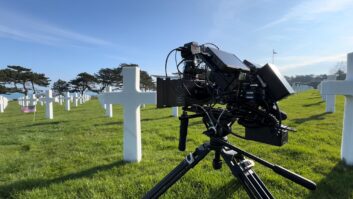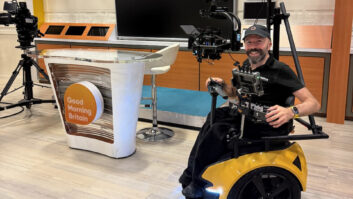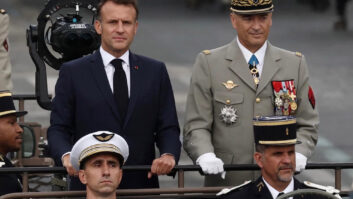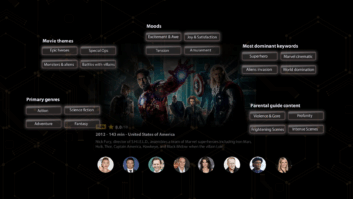
How would you deal with 81,000 clips in over 60 different formats?
When Executive Producer Ridley Scott called for filmmakers around the world to capture their life on camera on one particular day, over 80,000 clips were submitted. Some 24 researchers and multiple assistant editors were needed to reduce 4,500 hours of submitted video down to 220 hours for the final edit. George Jarrett got the full production story from Editor Joe Walker, who worked closely with Director Kevin Macdonald.
Life in a Day tells the story of 24 July 2010, all around our planet (the photograph shows an entry from Spain of a little girl who climbs up a human pyramid). The 95-minute release, coming out in July, has already wowed audiences at the Sundance Film Festival. It was produced from 81,000 clips, which arrived in more than 60 different formats and frame rates that would later cause huge frame-blending issues — but Editor Joe Walker started at the beginning of what were the most hectic five months of his working life.
“When we set up the project we were told there has been nothing comparable. We asked people at YouTube what to expect because we were trying to work out how many iMacs to buy, how many people to hire, and what languages to anticipate,” he says. “They said, that based on the YouTube Orchestra project, they thought we would get a multiple of the material they had for that response.
“Because we had a higher publicity impact, due to Ridley Scott’s trailer and star appeal, YouTube said we might get as many as 800 hours of clips. We ended up with over 80,000 clips and so we had to quickly hire a lot of people, and expand the system,” he adds. “We set up with about 12 researchers, but we ended up with 24, and that was because near to the finish we hired people who could just handle specific languages.”
The production company Scott Free found the researchers from film schools and it used people who had documentary or drama experience. This massive hiring process resulted in a giant Soho sweatshop at rented offices in Greek Street, London. In the meantime, Walker was thinking about a finishing route.
“The system took time to resolve. I had put out an appeal asking people to use the HD at 24fps setting if their camera had that facility. That would have made life very much easier, but unfortunately everybody ignored me and we ended up with 60 different frame rates,” he says.
“In fact it involved people using DSLR cameras, flip cams, Red cameras, and the endless variety of mobile phone formats. That was the big enemy of what we were doing, so we needed a system to make it editable; we were using the YouTube clips for tagging,” he adds.
The researchers were all tagging like mad, trying to find trends in the material. They also used a star rating system.
“They worked like this: one star was, ‘They have put less thought into it than we have in logging it’; two stars meant, ‘Cannot see where it is going and it is not shot well’; three stars meant, ‘Really well shot but cannot see where it is going to’; four stars was, ‘Interesting angles, interesting camera work and places, good time capsule material and strong stories’; and, five stars meant all four plus good characters,” says Walker.
“We kept true to our plan, thinking all along that we would finally edit from 2-300 hours. That was based on the necessity of seeing all this material with researchers once and then viewing the selected material with Kevin. We couldn’t view more than 200 hours in the time we had, because we ended up with only six weeks to cut it,” he adds. “It was all so tight, but it seemed to be the four and five star stuff that occupied about 220 hours.”
No intention for a structure
All of the logging and researching was done using CatDV. “It meant somebody could log downstairs and I could look at it upstairs – and we could both make notes,” says Walker. “It was a filtering system. If I pulled down a thing which said ‘master requested: yes’ that meant the production end could go into gear, and go back to the originator of the material and get it in a higher quality format. MP4 and FLV files are not good enough quality to show on a big screen!
“We always had this thing that we would watch clips as little 20 megabyte YouTube files, but as soon as we saw something that was a four or five star clip we needed to get the original material in as high enough possible quality fast,” he adds. “We set up FTP sites and that’s where eight Media Composers came into play because we needed to bring stuff in through ContentAgent and then start arranging the content through a system and then updating the pictures to try and deal with the frame blending issues.
“ContentAgent was extremely good at keeping things in sync and extremely good at putting things in the right aspect ratio, but actually it was one big blur some of the time,” he continues. “A cut would never be a cut. It would be over three frames because of the difficult conversions. We had to go back and use a variety of fixes to try and emulate a 24 fps system. For this we used Twixtor on Avid, which is why the Media Composers were so busy.”
One Apple FCP system appeared because many contributors had cut on it and it was the best way to get the right envelope to import things. Everything went up to Walker with 80 plus fields of metadata, but why so many?
“There was no simple way of searching for things on the system. It was that problem of transferring everything from one system to another. Kevin and I had viewed and logged, and changed clips using CatDV, but then that wasn’t a sufficiently good enough quality editing system,” he says. “I wanted to keep that stuff so I could search for words. With that amount of material you would get lost if you don’t have the right volumes of metadata.”
At what stage did Director Kevin Macdonald think he had a storyboard?
“We had this massive wall at the back and we just stuck everything on that. We then moved things around to get some kind of structure,” says Walker. “In fact there was no intention for a structure. We never knew how we would get from the beginning to the end. We could have thought in a number of ways, and in fact there isn’t one single, dominant structure.
“From midnight to midnight is the big one. That gives you a sense of time, but there are structures of light and dark, and birth and death. There are lots of those sorts of subjects that flow through the film, and you spend 20 minutes looking at relationships,” he adds. “There are enough shades to make it work, and very early on we saw a beginning and an ending. It was very lucky that we did, because what we did not know was that there would be a full moon on 24 July. And for some reason loads of YouTube fans are keen astronomers and they shot the moon while doing marvellous things – all over the world.”
All the eccentrics and mad dogs celebrating the full moon gave the creative combo their beginning. The end followed very quickly.
“A really lucky break happened. I saw a clip that featured a girl called Betsy. She is in her car at the end of the film summing up her day of filming; the things that she said seemed to sum up our film,” says Walker. “She says in the clip, ‘It is one or two minutes to midnight and I haven’t got very long’. It gave us this fantastic sense that we have got our beginning and our end. That was one of the most important things. You can join it up to make 95 minutes.
No time code or EDL
Walker used a tiny clip from what was a long piece about somebody’s father. Mischievously he and Macdonald took stuff from anywhere, and it did not have to be high quality all the way.
“There are some gloriously shot clips from good filmmakers, but best of all we sent out just under 500 digital stills cameras that could record 24fps HD content. These little Fuji film cameras were sent to places from where it is difficult to get material through the YouTube network,” says Walker. “The cameras were sent out through the charitable organisation Against All Odds, and they went to Afghanistan, some of the African nations and to places like Davis Station in Antarctica. The deal was that people keep the cameras but send us back the SD card.
“We feared that everything might end up on eBay, but the vast majority of those SD cards came back via Fed Ex and we ended up with some of the most exotic material from places like India and Peru. It was a low quality camera, but we always tried to work as hard as we could to make it look good,” he says.
Walker’s role did not relate to offline in any way, and it was unlike any online seen before.
“This is the first project I have ever worked on without any time code and without an EDL, so we were basically working online the whole time. The reason for the eight Avid Media Composers is that as I was going along I was finessing and finessing,” he says. “The first cut or assembly was about 210 minutes, and then very quickly, in the space of two weeks I had boiled that down to close to what the finished film became. While I was doing that the assistants were working all round the clock basically patching the best quality originals that had come through from the FTP site. They were using Twixtor as a fix to try and get rid of blurring issues, or just exporting TIFF sequences.”
In projects like this someone has to invent something special like a stunning plug in to solve a major issue, or bully software to do more than it was designed for. Was this the case?
“That is exactly what we had to do. For example, the Assistant Editor [Gwillym Hewitson] found a way of exporting things as a TIFF sequence,” says Walker. “There was no way of pulling stuff off the shelf and just starting. We just accumulated different parts of the thing that could do the job, and actually there were three weeks in the middle of the project when we did not know how to do it. And we were going to have to live with blurring.
“Sound was another very big problem, because the YouTube experience is normally clips being out of sync anyway due to the enormous technical processes involved, and because people upload things that are out of sync in the first place,” says Walker.
“So I was always adjusting by ear and by eye. My background is in films and I was used to syncing up, so I got used to slipping things all of the time. For my end I kept everything on the Avid. In the dubbing suite later they used Pro Tools. The big sound problem is not one straight technical issue. It is more to do with the sound recording quality on cameras and people’s intelligence about filmmaking,” he adds.
The one thing that Walker had not talked about fully was the editorial structure that prepared everything for him to cut with Macdonald. “Although we had loads of assistants working in a technical capacity, I also had two assembly editors working to find the best answers to questions,” he says.
“And at one stage, I got in two co-editors to help finesse things. So the size of the team was quite big. I still wanted to cut everything myself and I did, but at one point we had three assembly editors doing a fantastic job,” he adds.
ContentAgent: Metadata fields and MXF files
Owen Walker, Root6’s product manager for ContentAgent, arranged a rare hire deal with Scott Free. His summary of what happened is: “Out of the 81,000 clips, they would choose various selects each day – a bit like a typical film – and they would look at dailies and rushes and then choose which selects to prepare for editorial.
“Each day they would put clips through the two ContentAgent systems. They would be converted automatically into Avid DNxHD 24fps clips, and then the metadata from the CatDV system would be output via an XML file. The ContentAgent would then automatically link that data with the appropriate clip,” he explains.
“So the resulting MXF file, the Avid DNxHD file, was placed in a folder on an Avid Unity for storage, with all the metadata nicely provided with each clip. We wrote a special script to take those 80 plus metadata fields and populate the Avid MXF file with them.”
Assistant Editor Gwillym Hewitson adds: “ContentAgent helped us achieve an offline edit in an efficient way that would not have been possible working with other methods, given the time constraints. We had just over five months from the shooting day to a finished film, of which three months were absorbed in viewing and offline work.
“After logging 4,500 hours of original material in MP4 or FLV format on a different system, ContentAgent allowed us to bring in to Avid Unity 300 hours of the best stuff. This material had been generated by hundreds of different digital sources and with a blizzard of technical challenges of their own: every variety of codec and over 60 different frame rates,” he says.
“These all had to be unified into a single frame rate and Avid resolution with synced sound. While the software was not involved in the final conform of the film, where frame-blending issues were addressed, we could not have got there without it.”
www.revisionfx.com/products/twixtor/
www.root6technology.com
www.rsafilms.com/page/scott-free
www.squarebox.co.uk






